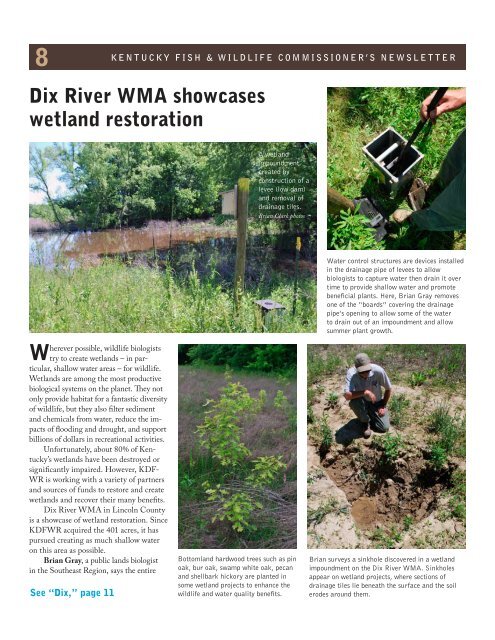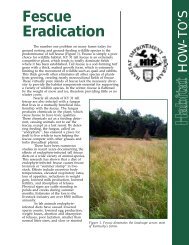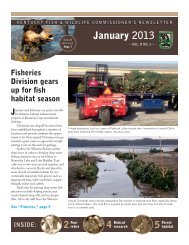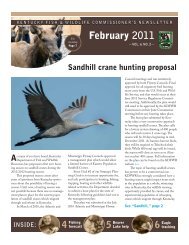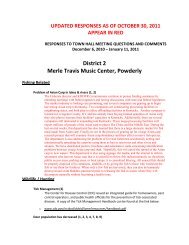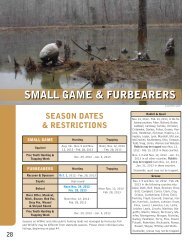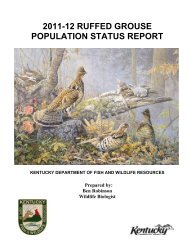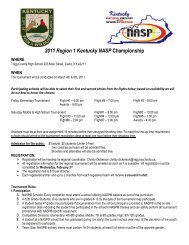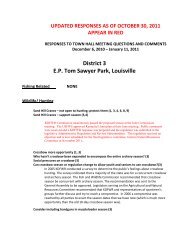August 2009 - Kentucky Department of Fish and Wildlife Resources
August 2009 - Kentucky Department of Fish and Wildlife Resources
August 2009 - Kentucky Department of Fish and Wildlife Resources
You also want an ePaper? Increase the reach of your titles
YUMPU automatically turns print PDFs into web optimized ePapers that Google loves.
8<br />
K E N T U C K Y F I S H & W I L D L I F E C O M M I S S I O N E R ’ S N E W S L E T T E R<br />
Dix River WMA showcases<br />
wetl<strong>and</strong> restoration<br />
Wherever possible, wildlife biologists<br />
try to create wetl<strong>and</strong>s – in particular,<br />
shallow water areas – for wildlife.<br />
Wetl<strong>and</strong>s are among the most productive<br />
biological systems on the planet. They not<br />
only provide habitat for a fantastic diversity<br />
<strong>of</strong> wildlife, but they also filter sediment<br />
<strong>and</strong> chemicals from water, reduce the impacts<br />
<strong>of</strong> flooding <strong>and</strong> drought, <strong>and</strong> support<br />
billions <strong>of</strong> dollars in recreational activities.<br />
Unfortunately, about 80% <strong>of</strong> <strong>Kentucky</strong>’s<br />
wetl<strong>and</strong>s have been destroyed or<br />
significantly impaired. However, KDF-<br />
WR is working with a variety <strong>of</strong> partners<br />
<strong>and</strong> sources <strong>of</strong> funds to restore <strong>and</strong> create<br />
wetl<strong>and</strong>s <strong>and</strong> recover their many benefits.<br />
Dix River WMA in Lincoln County<br />
is a showcase <strong>of</strong> wetl<strong>and</strong> restoration. Since<br />
KDFWR acquired the 401 acres, it has<br />
pursued creating as much shallow water<br />
on this area as possible.<br />
Brian Gray, a public l<strong>and</strong>s biologist<br />
in the Southeast Region, says the entire<br />
See “Dix,” page 11<br />
A wetl<strong>and</strong><br />
impoundment<br />
created by<br />
construction <strong>of</strong> a<br />
levee (low dam)<br />
<strong>and</strong> removal <strong>of</strong><br />
drainage tiles.<br />
Brian Clark photos<br />
Bottoml<strong>and</strong> hardwood trees such as pin<br />
oak, bur oak, swamp white oak, pecan<br />
<strong>and</strong> shellbark hickory are planted in<br />
some wetl<strong>and</strong> projects to enhance the<br />
wildlife <strong>and</strong> water quality benefits.<br />
Water control structures are devices installed<br />
in the drainage pipe <strong>of</strong> levees to allow<br />
biologists to capture water then drain it over<br />
time to provide shallow water <strong>and</strong> promote<br />
beneficial plants. Here, Brian Gray removes<br />
one <strong>of</strong> the “boards” covering the drainage<br />
pipe’s opening to allow some <strong>of</strong> the water<br />
to drain out <strong>of</strong> an impoundment <strong>and</strong> allow<br />
summer plant growth.<br />
Brian surveys a sinkhole discovered in a wetl<strong>and</strong><br />
impoundment on the Dix River WMA. Sinkholes<br />
appear on wetl<strong>and</strong> projects, where sections <strong>of</strong><br />
drainage tiles lie beneath the surface <strong>and</strong> the soil<br />
erodes around them.


